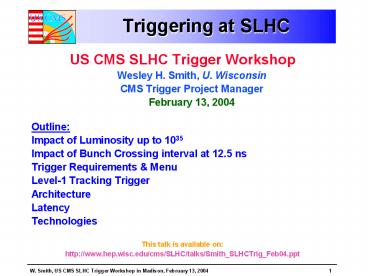Triggering at SLHC PowerPoint PPT Presentation
1 / 11
Title: Triggering at SLHC
1
Triggering at SLHC
- US CMS SLHC Trigger Workshop
- Wesley H. Smith, U. Wisconsin
- CMS Trigger Project Manager
- February 13, 2004
- Outline
- Impact of Luminosity up to 1035
- Impact of Bunch Crossing interval at 12.5 ns
- Trigger Requirements Menu
- Level-1 Tracking Trigger
- Architecture
- Latency
- Technologies
- This talk is available on
- http//www.hep.wisc.edu/cms/SLHC/talks/Smith_SLHCT
rig_Feb04.ppt
2
SLHC Trigger _at_ 1035
- Occupancy
- Degraded performance of algorithms
- Electrons reduced rejection at fixed efficiency
from isolation - Muons increased background rates from accidental
coincidences - Larger event size to be read out
- Reduces the max level-1 rate for fixed bandwidth
readout. - Trigger Rates
- Attempt to hold max level-1 at 100 kHz by
increasing readout bandwidth - Implies raising ET thresholds on electrons,
photons, muons, jets and use of less inclusive
triggers - Need to compensate for larger interaction rate
degradation in algorithm performance due to
occupancy - Radiation damage
- Increases for part of level-1 trigger located on
detector
3
SLHC Trigger _at_ 12.5 ns
- Choice of 80 MHz
- Reduce pile-up
- Retain ability to time-in experiment
- Beam structure vital to time alignment
- Higher frequencies continuous beam
- Rebuild level-1 processors to work with data
sampled at 80 MHz - Already CMS has internal processing up to 160 MHz
and higher in a few cases - Use 40 MHz sampled front-end data to produce
trigger primitives with 12.5 ns resolution
4
Synchronization _at_ 12.5 ns
Synchronization tasks procedures defined
together w/ sub-detectors
5
SLHC Trigger Requirements
- High-PT discovery physics
- Not a big rate problem since high thresholds
- Completion of LHC physics program
- Example precise measurements of Higgs sector
- Require low thresholds on leptons/photons/jets
- Use more exclusive triggers since final states
will be known - Control Calibration triggers
- W, Z, Top events
- Low threshold but prescaled
6
SLHC Level-1 Trigger Menu
- ATLAS/CMS Studies in hep-ph/0204087
- inclusive single muon pT gt 30 GeV (rate 25 kHz)
- inclusive isolated e/? ET gt 55 GeV (rate 20
kHz) - isolated e/? pair ET gt 30 GeV (rate 5 kHz)
- or 2 different thresholds (i.e. 45 25 GeV)
- muon pair pT gt 20 GeV (rate few kHz?)
- jet ET gt 150 GeV.AND.ET(miss) gt 80 GeV (rate
1-2 kHz) - inclusive jet trigger ET gt 350 GeV (rate 1 kHz)
- inclusive ET(miss) gt 150 GeV (rate 1 kHz)
- multi-jet trigger with thresholds determined by
the affordable rate
7
SLHC L-1 Tracking Trigger
- Additional Component at Level-1
- Will use on-detector wireless interconnects
- Line of sight VCSELS, Bluetooth?
- Provides outer stub and inner track
- Combine with calorimeter at L-1 to reject ?0
electron candidates - Reject jets from other crossings by z-vertex
- Reduce accidentals and wrong crossings in muon
system - Consequence is that Cal Muon L-1 must produce
output with suitable granularity to combine with
L-1 tracking trigger - Also need to produce hardware to make
combinations - Move some HLT algorithms into Level-1
8
SLHC Trigger Architecture
- LHC
- Regional to Global Component to Global
- SLHC Proposal
- Combine Level-1 Trigger data between tracking,
calorimeter and muon at Regional Level at finer
granularity - Forward physics objects made from tracking,
calorimeter and muon regional trigger data to the
global trigger - Implication performing some of tracking,
isolation and other regional trigger functions in
combination between regional triggers
9
Level-1 Latency
- Present Latency of 3.2 ?sec becomes 256 crossings
- Assuming rebuild of tracking preshower
electronics will store this many samples - Do we need more?
- Yield of crossings for processing only increases
from 70 to 140 - Parts of trigger already using higher frequency
- How much more? Justification?
- Combination with tracking logic
- Increased algorithm complexity
- Finer result granularity
10
Technologies for SLHC Trig.
- Complicated Algorithms Low Latency
- FPGAs faster, more logic
- Faster and larger memories
- Moving more data at higher speed
- Link technology speed integration
- Backplane technology connectors newer
interconnect technology - Higher Crossing Frequency
- High speed clocking low jitter - design for
links - Overall Complexity
- Design for test, diagnostics, algorithm validation
11
SLHC Trigger Roadmap
- This workshop
- Survey of ideas we should explore in US CMS
- CMS Workshop at CERN Feb 26, 27
- Provide summary of ideas and gather ideas from
CMS - Summer CMS Workshop (not scheduled)
- Propose initial plan of Trigger RD for FY05
- Develop overall CMS plan for Electronics RD
- Not detailed, just timescales for development
reporting - Long Term
- RD 2005-7
- Prototype/Test 2008-10
- Construct/Install 2010-13

